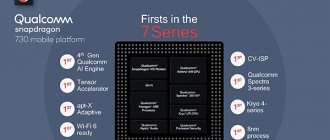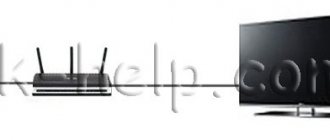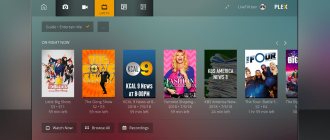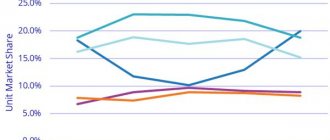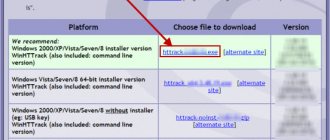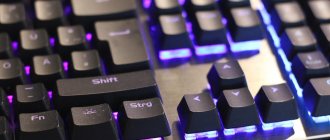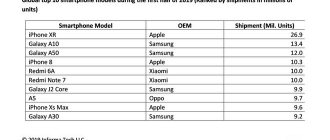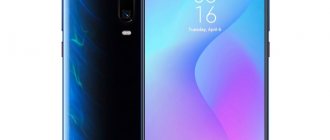Announcement: 2015
The most budget chipset for the most budget tablets with support for LTE networks.
There are a large number of varieties, differing in the operating frequency of processor cores, supported screen and camera resolutions, etc. It is also possible that different numbers of GPU cores are used, but reliable information on this is difficult to find.
However, usually device manufacturers prefer not to indicate at all what type of chipset they are talking about. And even if they do indicate, this information cannot always be trusted.
Varieties (we can’t guarantee 100% accuracy, but it seems to be something like this):
- MT8735M – 1000 MHz, screen up to 1024×600, camera up to 8 MP
- MT8735D – 1100 MHz, screen up to 1280×800, camera up to 13 MP
- MT8735P – 1000 MHz, screen up to 1920×1080, camera up to 8 MP
- MT8735B – 1100 MHz, screen up to 1280×800, camera up to 13 MP
- MT8735A – 1450 MHz, screen up to 1920x1200
- MT8735W – 1300 MHz, screen up to 1920×1200
| Cores | 4 x Cortex-A53 1300 MHz |
| GPU | Mali-T720 |
| Technical process | 28 nm |
| Bit depth | 64 bit |
| Maximum frequency | 1300 MHz |
| RAM | LPDDR3 |
| Networks | LTE Cat.4, 3G, 2G |
| Navigation | GPS, GLONASS, Beidou, Galileo |
| Camera | 13 MP |
| Screen | 1920×1200 |
| Other | Wi-Fi a/b/g/n |
| AnTuTu7 | 41776 |
| AnTuTu6 | 30940 (24449-36177, 7) |
| AnTuTu5 | 21663 (19029-27629, 4) |
Tablets (170)
2019
- Digma Plane 8580 4G
- INOI Tab8
- Irbis TZ772
- Irbis TZ878
- Irbis TZ897
2018
- Acer Iconia One 10 (B3-A42)
- BQ BQ-8041L Art
- Bravis NB108 4G
- Bravis NB871 4G
- Chuwi Hi8 SE
- DEXP Ursus L110 4G
- DEXP Ursus L180 4G
- DEXP Ursus S110 4G
- Digma CITI 1578 4G
- Digma CITI 3000 4G
- Digma Optima 1025N 4G
- Digma Optima 7018N 4G
- Digma Optima 8019N 4G
- Digma Plane 1553M 4G
- Digma Plane 1573N 4G
- Digma Plane 7563N 4G
- Digma Plane 8021N 4G
- Digma Plane 8555M 4G
- Digma Platina 1579M 4G
- Impression ImPAD P104 Android 8.1
- Irbis TZ197
- Irbis TZ797
- Navitel T757 LTE
- Nomi C070034 Corsa4 7 LTE
- Nomi C070044 Corsa4 Pro 7 LTE
- Nomi C080044 Libra4 Pro
- Nomi C101034 Ultra4 LTE 10
- Nomi C101044 Ultra4 LTE Pro
- PiPO N1
- Prestigio Grace 5588 4G
- Prestigio Grace 5718/5778 4G
- Prestigio Grace 5771 4G
- Prestigio Grace 5791 4G
- Prestigio Grace 7781 4G
- Prestigio Grace 7788 4G
- Prestigio Wize 3537 4G
- TurboPad 1016 4G
- Vertex Tab 4G 10-1
- Vertex Tab 4G 8-1
2017
- ASUS ZenPad 10 (Z301MFL)
- ASUS ZenPad 10 (Z301ML)
- Acer Iconia One 10 (B3-A32)
- Alcatel A3 10″ 4G
- Archos 101c Helium
- Archos Core 101 4G
- Archos Sense 101X
- BQ BQ-1054L Nexion
- DEXP Ursus P170 4G
- DEXP Ursus P180 4G
- Digma CITI 1508 4G
- Digma CITI 1510 4G
- Digma CITI 7528 4G
- Digma CITI 8527 4G
- Digma CITI 8542 4G
- Digma Optima 1315T 4G
- Digma Optima 8100R 4G
- Digma Optima 8701B 4G
- Digma Plane 1506 4G
- Digma Plane 1526 4G
- Digma Plane 1538E 4G
- Digma Plane 1541E 4G
- Digma Plane 1551S 4G
- Digma Plane 7521 4G
- Digma Plane 7539E 4G
- Digma Plane 8540E 4G
- Irbis TZ771
- Irbis TZ790
- Irbis TZ890
- Lenovo Tab 4 7 Essential TB-7304[FiX]
- Lenovo Tab 7 TB-7504[FX]
- Nomi C070030 Corsa3 LTE
- Nomi C101030 Ultra3 LTE
- Nomi C101040 Ultra3 LTE Pro
- Philips E Line 4G TLE821L
- Prestigio Grace 3101 4G
- Prestigio Grace 3157/3257 4G
- Prestigio Grace 3201 4G
- Prestigio Grace 3301 4G
- Prestigio Wize 3418/3518/3618 4G
- Supra M14A 4G
- Supra M74D 4G
- Supra M84A 4G
- Vodafone Smart Tab N8
2016
- 4Good Light AT200
- Acer Iconia Talk S (A1-734)
- Ainol AX10 Pro
- Archos 101 Helium Lite 4G
- Archos 101b Helium 4G
- Digma CITI 1903 4G
- Digma CITI 1904 4G
- Digma CITI 7901 4G
- Digma Optima 1105S 4G
- Digma Optima 1300T 4G
- Digma Plane 1700B 4G
- Digma Plane 1701 4G
- Digma Plane 1702B 4G
- Digma Plane 1710T 4G
- Digma Plane 7010M 4G
- Digma Plane 7011M 4G
- Digma Plane 7700B 4G
- Digma Plane 9506 4G
- Irbis TZ11/TZ12
- Irbis TZ16
- Irbis TZ17
- Irbis TZ83/TZ84
- Irbis TZ87
- Lenovo Tab 3 10 Business TB3-X70[FL]
- Lenovo Tab 3 7 TB3-730X
- Micromax Canvas Tab P701
- Oysters T104B 4G
- Oysters T104ER 4G
- Oysters T74HMi 4G
- Oysters T84Bi 4G
- Oysters T84Ni 4G
- Prestigio MultiPad Wize 3407 4G
- Prestigio MultiPad Wize 3408/3508/3608 4G
- Supra M14CG
- Supra M14DG
- Supra M84AG
- Teclast P80 4G
- Teclast T98 4G
- bb-mobile Techno 10.1 LTE TQ060X
- teXet TM-8043
- Beeline Tab Fast 2
- Megafon Login 4 LTE tablet
2015
- Archos 70b Helium 4G
- BQ-7006G Union
- DEXP Ursus TS110 4G
- DEXP Ursus TS170 4G
- DEXP Ursus TS270 Star 4G
- Digma Hit 4G LTE
- Digma Plane 7.4 4G LTE
- Ginzzu GT-W131 4G
- Ginzzu GT-W170 4G
- Ginzzu GT-X770 4G
- Ginzzu GT-X890 4G
- Irbis TX14
- Irbis TX19
- Irbis TX27
- Irbis TX28
- Irbis TX51
- Irbis TX52
- Irbis TX76
- Irbis TX88
- Irbis TX89
- Irbis TX90
- Irbis TZ70
- Irbis TZ71
- Irbis TZ72
- Lenovo Tab 2 A8-50
- Oysters T74MR 4G
- Supra M14AG
- Supra M74HG
- Supra M74LG
- Supra M74MG
- Supra M94CG
- Teclast P70 4G
- Tesla Impulse 7.0 LTE
- Tesla Impulse 8.0 LTE 2015
- Wexler.TAB 7 LTE
- bb-mobile Techno 7.0 LTE Kalash TQ763I
- teXet TM-7879 X-pad Rapid 7.1 4G
- teXet TM-7889 X-pad Rapid 7.2 4G
- teXet TM-8066 X-pad Rapid 8.2 4G
- Beeline Tab Fast
MediaTek vs Snapdragon: everything you need to know
Among all Android smartphone manufacturers, only Huawei and Samsung use proprietary processors. Other companies create their gadgets based on chipsets from Qualcomm and MediaTek. Both of these companies have dominated the market for third-party mobile chipset developers for several years following the exit of players such as Texas Instruments, Intel and NovaThor.
We offer you a comparative analysis of MediaTek and Qualcomm as two leaders in their field.
CPU Manufacturing Technologies
As for the technologies used in the construction of CPUs, Qualcomm has previously created its own Kryo cores. Since 2020, the company has moved to more standard Kryo Gold and Kryo Silver cores, built on Arm cores, which are more performant and more energy efficient.
MediaTek also uses Arm cores, but does not modify them like Qualcomm does.
Qualcomm is using the latest and most powerful cores, such as in the new Snapdragon 675 processor. MediaTek is not yet using the latest Arm designs (Cortex-A76, A75 and A55). From this comparison, only one conclusion can be drawn - both Qualcomm and MediaTek use the same cores in their processors, but the first company quickly adapts the newest ones to its needs.
GPU: Qualcomm's secret weapon
Graphics coprocessors are a serious advantage for Qualcomm. It exists thanks to Adreno graphics processing technology, which Qualcomm acquired through its acquisition of AMD's handheld GPU division (Adreno is an anagram of Radeon, AMD's graphics brand).
Adreno graphics coprocessors are currently outperforming Mali coprocessors - this can be seen in benchmarks, for example, of Galaxy S9 smartphones with Qualcomm-based chipsets in comparison with the same phone models based on Exynos chipsets. To get around this and give their phones an edge, Samsung and Huawei are simply using more Mali GPUs. This allows them to catch up with Qualcomm with Adreno coprocessors, closing the gap - but only due to quantity.
The new Mali-G76 GPU will be a significant breakthrough, but Qualcomm developers are preparing a worthy response to it and plan to announce a new flagship graphics processor in December.
Machine learning
In recent years, Qualcomm has been using its Hexagon digital signal processor (DSP) for machine learning tasks. It performs tasks related to audio processing, photo processing, as well as some types of connections. This company, unlike Apple and Huawei, did not develop a separate processor for artificial intelligence tasks.
The latest Hexagon 685 DSP is used in the Snapdragon 845, Snapdragon 710, Snapdragon 670 and Snapdragon 675 chipsets. Therefore, smartphones based on these processors cope better with image recognition tasks.
MediaTek, in turn, presented its AI processing unit (APU) for mid-range phones based on the Helio P60 chipset. This block is designed to recognize faces and images during shooting.
Developer support and software updates
If you plan to change the firmware on your phone, then it will be easier to do this with a Qualcomm-based device. Smartphones with MediaTek processors do not receive the latest firmware so quickly, but this is due to the company’s policy regarding source code.
In addition, developers of budget devices, which are mainly equipped with MediaTek processors, do not update the software themselves for a long time. Therefore, the lack of software updates is often associated with problems of phone manufacturers, and not the MediaTek representatives themselves. The company is trying to change this situation by offering its partners GMS Express, a more complete version of Android with several Google applications, instead of the standard AOSP build.
Project Treble from Google, in turn, also accelerated the receipt of software updates for devices based on both Qualcomm and MediaTek processors due to the fact that the dependence of Android software on hardware features was reduced.
However, Qualcomm still leads in software updates and developer support.
Devices based on Qualcomm and MediaTek
MediaTek is very successful in creating processors for low-end and budget smartphones such as Nokia 1, Nokia 3 and 3.1, as well as Redmi 6 and 6A. The new Helio A22 and P22 processors, designed for low-cost and simple smartphones, are smaller in size than their competitors from Qualcomm.
For budget models, Qualcomm still offers outdated Snapdragon 212 and Snapdragon 425 processors. We hope that their new developments, Snapdragon 429 and Snapdragon 439, will improve the picture.
Among the flagship devices, of course, devices based on Qualcomm Snapdragon 800 series processors (Snapdragon 835 and 845) dominate. Mediatek made a foray into the flagship processor market with last year's Helio X30 chipset. But so far this processor can only be found in Meizu Pro 7 Plus, while Qualcomm Snapdragon 835 is built into almost all top smartphones.
In mid-line phones you can find Qualcomm Snapdragon processors of the 400, 600 and 700 series, but also those developed by MediaTek Helio P60 and MT6750. The latter powers Nokia 5.1 Plus, Realme 1, Oppo F9, LGQ7 and LG X Power 2, while the former powers Nokia 7 Plus, Xiaomi Mi A2, Xiaomi Redmi Note 5 and Realme 2 Pro. Therefore, it is difficult to name a leader here.
So who wins?
Users choose smartphones not only and not so much depending on what processor they use. Some people simply care about a productive device, while others want to get a high-quality camera, moisture protection and a 3.5 mm audio jack for their money.
If you buy a flagship, it will most likely be powered by a Qualcomm processor. In mid-range smartphones you can find both Helio P60 chipsets from MediaTek and Qualcomm Snapdragon 660. Both chipsets are approximately equal in performance, but the new 600 series processors from Qualcomm are likely to be more powerful than the Helio P60.
Among entry-level smartphones, MediaTek dominates with its Helio A22 and P22 chipsets. Not only are they smaller, but they also offer more modern connections such as Bluetooth 5.
It is also important that processors from MediaTek are cheaper than their competitors from Qualcomm. Therefore, smartphones based on them are often more affordable, although this does not mean that they are of worse quality.
Oukitel K8, or Another smartphone based on MediaTek MT6750T
Hi all. Today's review is dedicated to the rather controversial Oukitel K8 smartphone. Why ambiguous? Yes, because it is impossible to release smartphones running on the MT6750T at the end of 2020, and already at this point one could say that the smartphone does not deserve attention, but 4 GB of RAM, 64 GB of internal memory, a decent display and a high-quality case speak of that you should still look at it.
Main technical characteristics:
- 6-inch display with a resolution of 2160x1080 pixels (18:9);
- eight-core MediaTek MT6750T processor with a frequency of 1.5 GHz;
- Mali-T860 MP2 graphics accelerator;
- 4 GB RAM;
- built-in 64 GB storage;
- support for microSD memory cards up to 256 GB;
- dual main camera with 13 and 2 megapixel modules;
- 5 megapixel front camera;
- battery with a capacity of 5,000 mAh with support for fast charging 5V/2A;
- fingerprint scanner + face recognition function;
- two slots for SIM cards;
- 2G: GSM 1800MHz,GSM 1900MHz,GSM 850MHz,GSM 900MHz;
- 3G: WCDMA B1 2100MHz,WCDMA B8 900MHz;
- 4G LTE: FDD B1 2100MHz,FDD B20 800MHz,FDD B3 1800MHz,FDD B7 2600MHz,FDD B8 900MHz;
- WIFI: 2.4G/5G WiFi,802.11a/b/g/n;
- Android 8.0 Oreo.
Packaging and delivery
The smartphone is delivered in a thick, white cardboard box. The top cover contains company logos.
On the reverse side there are stickers with brief technical characteristics of the device and IME numbers.
Inside the box, in a white plastic tray, there is a smartphone, dressed in a silicone, transparent bumper case.
Under the tray, in another similar white plastic tray are located:
- Power adapter 5V/2A;
- micro USB cable;
- Brief instructions;
- Warranty card;
- Clip.
The scope of delivery can neither be called rich nor modest. He's not bad.
Design and appearance
The smartphone has the appearance of a classic candy bar with rounded corners. On the front surface, in the upper part, there are the main sensors (proximity and refreshment sensors), a front camera window and a speaker.
There is a relatively small “beard” at the bottom. She is absolutely clean. On-screen control buttons.
All the remaining space is occupied by a high-quality 6.0” display, the resolution of which is 2080x2160 pixels, pixel density 480 dpi. The display has a newfangled aspect ratio of 18:9, the top of the display is covered with glass made using 2.5D technology. The manufacturer says that the glass is made using asahi glass technology. The frames are quite large and are approximately 2-3 mm on the left and right, and 8-9 mm on the top and bottom.
The display has excellent viewing angles, a decent amount of brightness and is capable of accepting up to 10 simultaneous touches.
On the back side, in the upper part, there are two camera modules, a fingerprint scanner just below, and an LED flash to the right.
At the bottom there is the company logo and the address of the company's official website.
The cover itself is made of matte plastic and does not collect fingerprints.
The side frame is made of metal, which gives the smartphone additional, pleasant weight. On the left side there is a combined tray for memory cards in micro SD format and SIM cards in nano-sim format.
On the right side there is a volume rocker and an on/off button.
At the bottom there is a symmetrical, stylized grille, behind which a polyphonic speaker is hidden; between the grilles there is a connector for connecting to a charger and synchronization, in micro USB format. To the right is the microphone.
On the top surface there is a 3.5mm jack, which can hardly be called standard, because many manufacturers are starting to abandon its use.
In general, the smartphone looks quite decent, has a pleasant weight, and fits well in the hand.
The included silicone case is of very mediocre quality, but will provide minimal protection.
Hardware and performance
The heart of the smartphone is the outdated MediaTek MTK6750T. This is an eight-core, 64-bit processor with four cores capable of operating at frequencies up to 1.5 GHz, and four cores at frequencies up to 1.0 GHz. An even more ancient, dual-core ARM Mali-T860MP2, capable of operating at frequencies of up to 700 MHz, is responsible for the graphics in this one.
The manufacturer decided to somehow compensate for the rather weak configuration of the SoC with the amount of RAM. The smartphone has 4 GB of memory, and the smartphone is also equipped with 64 GB of internal memory.
More detailed information on technical characteristics can be obtained in specialized applications.
System performance was assessed in synthetic tests.
In the popular AnTuTu test, it scores only 55922 points, and, by and large, that says it all. It’s already the end of 2020, what 55922? Top devices score more than 300,000, but here it’s only 55,000.
Although, most devices running on this SoC configuration gain even less. I don’t think there will be users who will want to play on this smartphone. With such performance, you can forget about games.
However, to my greatest surprise, almost all the heavy games that I launched ran on the smartphone. Even if the graphics settings are minimal, the games work.
Like most modern smartphones, Oukitel K8 is equipped with a fingerprint scanner, which is located on the back cover, just below the camera. For me personally, this is one of the most convenient locations for this scanner. There are no complaints about the work. Surprisingly, unlocking a smartphone takes quite a bit of time, about 0.3-0.5 seconds, the response rate is very good. The settings interface is standard. The manufacturer has not added anything new.
The Oukitel K8 smartphone has a minimal set of radio modules. The chipset itself has a built-in MT6176 modem that supports TE FDD/TDD R11 Cat-6 with 2x CA standards. DC-HSPA+, TD-SCDMA, EDGE .CDMA2000 1x/EVDO Rev. A(SRLTE). Smartphone operating frequency range:
- 2G: GSM 1800MHz,GSM 1900MHz,GSM 850MHz,GSM 900MHz
- 3G: WCDMA B1 2100MHz,WCDMA B8 900MHz
- 4G LTE: FDD B1 2100MHz,FDD B20 800MHz,FDD B3 1800MHz,FDD B7 2600MHz,FDD B8 900MHz
There is no need to complain about the operation of the telephone module. The smartphone picks up the 4G signal well (at least in urban conditions), the quality of the speaker and microphone is at a decent level.
The polyphonic speaker sounds loud enough, but the sound lacks richness. The sound is loud, but there is an overabundance of high frequencies. This is observed in the vast majority of Chinese (and not only Chinese) smartphones.
Oukitel K8 is equipped with a dual-band WiFi module: 2.4G/5G (802.11a/b/g/n). The quality of the module is checked by a traditional test. Measurements were made at various distances from the signal source.
1. In close proximity to the signal source.
2. At a distance of 4-5 meters from the signal source, behind a gas silicate wall.
3. At a distance of 10-12 meters from the signal source, behind a thick brick wall.
2.4 GHz:
5.0 GHz:
Under similar conditions, the speed of connection to the Internet was tested.
2.4 GHz / 5.0 GHz:
The built-in GPS and GLONASS modules are responsible for determining coordinates on the ground. A cold start takes only 3-4 seconds. Accurate determination of coordinates occurs in approximately 20-30 seconds. The signal reception quality is decent.
Software
Out of the box, Oukitel K8 comes pre-installed with OS Android 8.1, which is currently practically the most modern version of this operating system. The interface is standard; at first glance, the manufacturer has left everything as it is. Standard icons, standard curtain, standard launcher, and of course this is important, taking into account the SoC configuration. Unnecessary applications pre-installed on the system and improving the interface can significantly reduce system performance, so it seems to me that the manufacturer’s decision was quite obvious and correct.
The localization of the interface is done quite well. There are several menu items that were bypassed by translation, but this is common to all Chinese smartphones from the third tier.
In addition to the fingerprint scanner, the Oukitel K8 smartphone has a facial recognition function. An interesting function, it works quite quickly, provided there is good lighting.
The setup procedure is quite simple, all the necessary instructions are there, and they are in Russian.
In general, there are no complaints about the operation of the system interface; everything works quickly and without slowdowns.
The smartphone has support for FOTA updates, but whether they will arrive or this is a marketing ploy remains unclear. At the time of writing this review there are no updates.
Camera
Oukitel K8 has not prepared anything new for us. The smartphone has a budget set of camera modules. There are two modules on the back surface. The main 13-megapixel Sony IMX135 sensor and an additional 2-megapixel sensor, which in theory should measure exposure, etc.
Examples of photos taken with the main camera.
There is no information about the manufacturers of the front camera. It is known that it is equipped with a 5-megapixel sensor.
Examples of photos taken with the front camera.
As you can see, in bright, sunny weather, photographs are of more or less tolerable quality.
Battery and autonomy
The autonomy of the Oukitel K8 is ensured by a fairly capacious rechargeable battery with a capacity of 5000 mAh. The included charger is 5V/2A, and this means that we are not talking about any fast charging, and this is sad.
The validity of the declared battery capacity is checked using a USB tester.
The results of synthetic tests showed that the smartphone is able to work under load for more than 9 hours, and this is a very decent indicator. Unfortunately, the screenshots of this test were not saved, but you can evaluate how the battery charge level changed from 50% to 20% from the screenshots below.
In standby mode, the smartphone can work for a whole week.
With everyday use, the battery capacity lasts for two days.
Advantages
- Build quality;
- Metal body frame;
- High-quality display;
- Autonomy;
- Amount of RAM and internal memory;
- Operation of FaceID and fingerprint scanner;
- Quality of radio modules.
Flaws
- SoC configuration;
- Price.
Conclusion
To sum it up, it’s very difficult for me to say which emotions are stronger from using a smartphone. The smartphone really has a number of positive features (high-quality display, with a large margin of brightness and contrast, excellent battery, large amount of RAM and internal memory...), but the SoC configuration is very depressing, and the point is not even that you won’t be able to play on the smartphone , with pleasure, in your favorite games, the fact is that for inexplicable reasons, third-tier Chinese manufacturers diligently use obsolete processors. In fact, it is the SoC configuration that will make users think twice when choosing a tablet like this.
Link to the product

